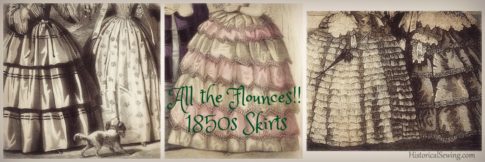
If you love making and wearing flounces (aka deep ruffles) then welcome to 1850s fashion!
Stuck between the demure, sweet, simple trends of the 1840s and the billowing hoops and war-torn fashions of the early 1860s, came the frilly, airy, and fanciful 1850s styles. This decade was all about the Skirt. (Oh, and the sleeves too, but that’s for another article.)
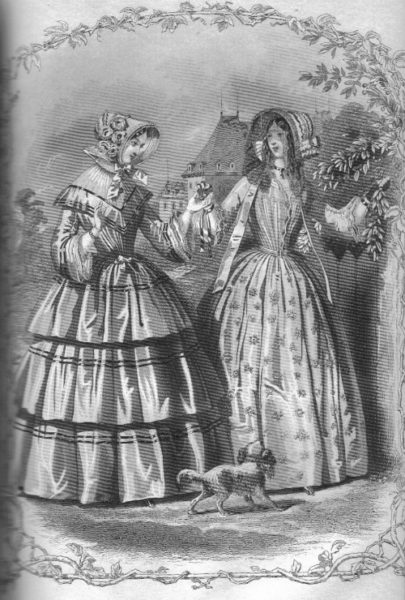
When our ancestors saw 1850 arrive, skirts were generally one layer with the fullness cartridge pleated or narrow knife pleated to the waist size and mounted to the inside of the bodice as they had been done throughout the 1840s.
You could also find the center front tablier (apron front), which was so popular throughout the 1830s and 40s, still making a statement on the skirt all the way through to 1860.
During the 1850s skirts could be mounted onto a separate waistband and worn separately or with the band tacked to the bodice for a one-piece dress. By the mid-1850s the two would remain separate except for the small hook and bars linking them together at center back and side seams on some styles.
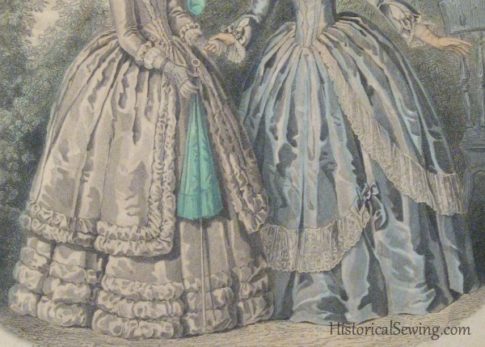
Supporting the full skirt silhouette were layers of petticoats with a corded petticoat being the primary foundation support with others plain, ruffled or tiered or embroidered.
But if there’s anything that would describe skirts in the 1850s it would definitely be Flounces!
Sometimes one, sometimes five, but usually two or three. A skirt could be ruffle-y goodness with a dozen tiny rows or a simple border print running along the horizontal hem.
The sketch below, from Godey’s Lady’s Book, April 1855, shows “twenty to twenty-four flounces” (left) and a simple 3-tiered skirt (right) with trim on each ruffle and at the hem. Oh My Ruffles!!
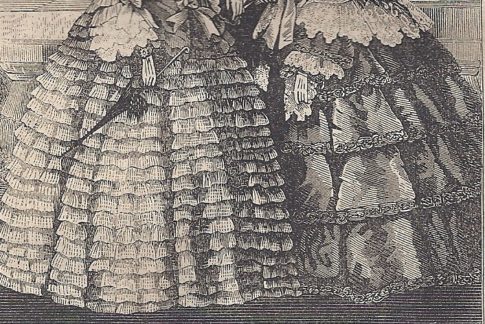
With à la disposition fabrics, the textile was printed with a wide border along one or both selvedges. The skirt panels would be cut on the cross (down the length of fabric) and gathered or pleated to fit the waist. If you had the money for several yards, the more border print flounces you could create; although, most à la disposition skirts were two to five layers.
Trim on each flounce was widely seen in this decade. Fringe was THE trim on skirts in the mid-Victorian period along with ribbons, self-fabric trim and flowers.
“Four rows of heavily-knotted fringe upon the skirt” was the suggestion in January 1851 from Godey’s Lady’s Book. And in January 1855: “with four flounces of less than the usual fullness; each of these has two rows of velvet ribbon an inch in width.”
“Many of the handsomest silk dresses have trimmings of black velvet. For instance, a dress of green silk has three deep flounces; upon each six rows of narrow velvet ribbon are disposed in a large festoon pattern. Rosettes, composed of twenty or thirty loops of narrow velvet ribbon, are fixed at the points where the upper part of the festoons adjoin each other; these points reach nearly to the top of the flounce, and the rosettes just fill the interval they leave.”
~Godey’s Lady’s Book, January 1855
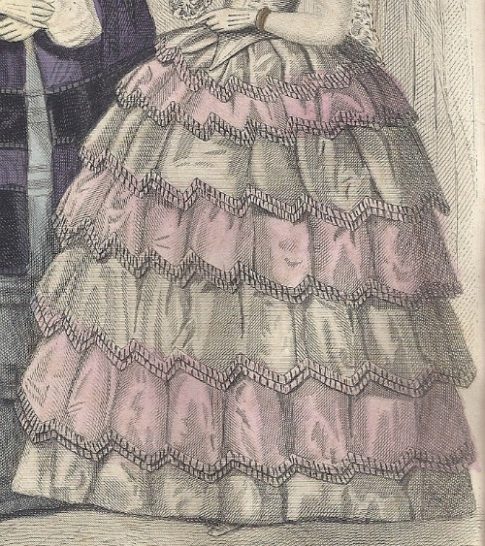
If you had money to splurge on your gown, each flounce could be made simply of deep lace – no other trim necessary! (This would be to make your friends drool, of course.)
The main historical method of making up a lightweight flounced skirt is to sew a base skirt of muslin and attach your flounces or deep ruffles to the base instead of taking each layer up to the waistband. When doing this, remember to make your base in a firm cotton and matching color to the flounces.
If you’re really daring and want to take a leap from mainstream fashion, consider that the Bloomer Costume made its mark in 1851 and was worn by Amelia Bloomer until 1859. Simply keep the top flounce of your skirt (length being to the knees) and add harem pants in the same fabric.
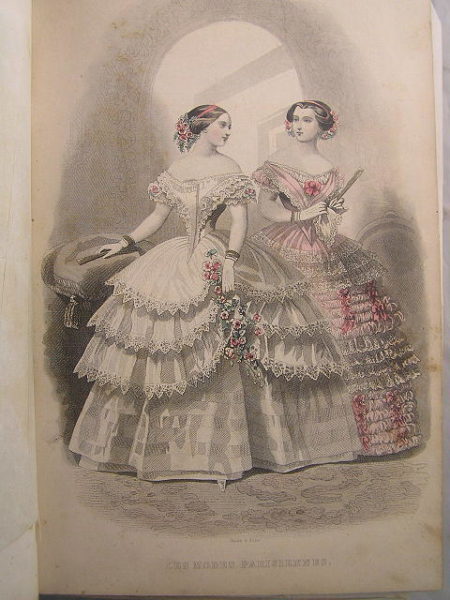
As the decade progressed, so did the skirt silhouette in getting wider and wider at the hem.
Along with this were the methods of keeping the skirt looking full and standing away from the body. Under all these poof-y skirts were worn multiple layers of petticoats, many flounced and embroidered themselves. Some even had straw braid to stiffen the hem.
Then in 1856 came a patent that would change women’s fashions – the steel cage crinoline. (Can you hear the choir of angels?)
Now with a firm understructure, the skirt could grow even larger. Fewer petticoats were needed and the corded petticoat, or crinoline, was cast aside. You can clearly see the fuller dome shape take over versus the heavy bell shape of the early decade years.

Single overskirts were added to the basic skirt as it lay over the new metal frame. While flounces were still in style, they were less popular as in earlier years. And as material became more expensive and scarce during the early 1860s, those extra fabric layers were completely left off.
To make your own fluffy, flounce-y 1850s dress, start with calculating how much yardage you’ll need for those ruffles. Then follow my post on figuring out the where and how of your ruffles.
If you are shorter or taller than average (or simply want to figure your skirt ruffles to match those of your fashion plate) and don’t mind a little math, I give tips here on how to do those calculations.
Then, follow these steps to sew them to your base without tearing your hair out. Prance around in your new fluffy skirt!
Have you made a 1850s costume that you adore? Have you used a special fabric for skirt flounces?

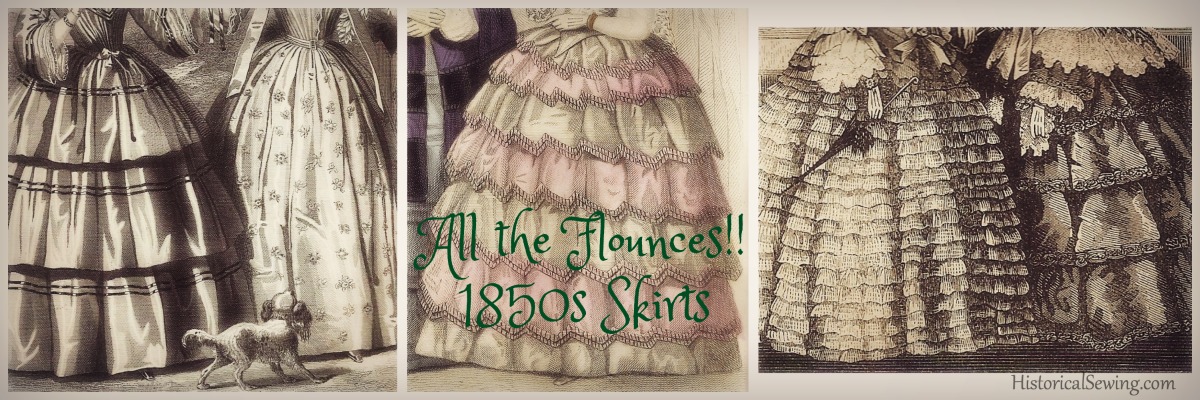
In making a flounced skirt of an expensive material, is it reasonable to use a more affordable fabric for the invisible part of the skirt, upon which the flounces are mounted? or should it be made of the same material as the rest of the dress?
Absolutely do-able! You’ll see lots of originals with a base/foundation fabric in generic cotton (primarily used) with silk or wool fashion fabric mounted on top. You can do the same with your pricey fabric over a cotton base. I’d recommend a tan or gray or black base or even a color similar to your fashion fabric.
Are border-printed fabrics still available? If so, where would they be sold? I have searched what seems like the entire internet and not found them.
Yes, they can still be found. Although, I’ll say the designs and textiles aren’t nearly as lovely as they used to be. I’ve seen border prints from Gertie (Charm Patterns), at Fabric dot com, Farmhouse Fabrics, and even local JoAnn Fabrics. Also, there are designs at Spoonflower you can search through.
A little late to comment on this, but with flounced petticoats would the flounces go up to the waist or be mounted to the skirt under the next flounce up? Your post here is one of very few sources I’ve been able to find about 1850s dresses
In this era (and in my research), the flounces are set on separately as ruffles with the upper flounce covering the next seam below it. The top flounce could go into the waistband or be set onto the skirt base a little down to keep bulk out of the waist area.
Not sure about construction, but sites like the Met Museum and Augusta Auctions have good photos of antiques. You can search for 1850s skirts/dresses and perhaps their photos can give you more clues for your research.
I’m reconstructing an 1856 dress with no tiers. For the corded petticoat (96″ skirt circumference with a 25″ waist), normal petticoats, and skirt, which pleating method should I use? I am having trouble figuring this out.
In my research, the front and sides would be in deep knife pleats with the back little section in cartridge pleats. At this time, however, we see skirts fully cartridge pleated, too.
I think I want to make a two tiered skirt, can I just cartridge pleat the two layers of taffeta together?
Yes. You can baste them at the top and pleats as usual.